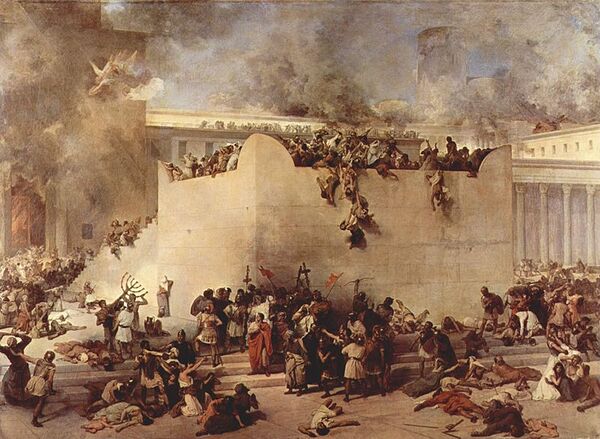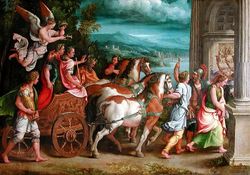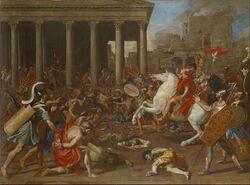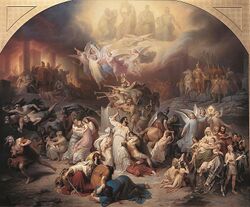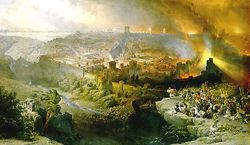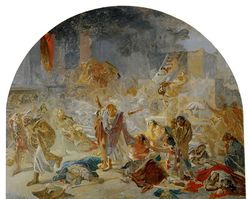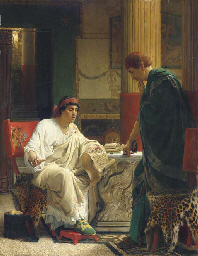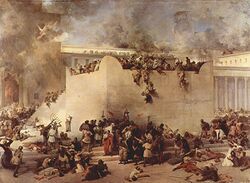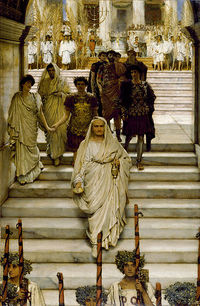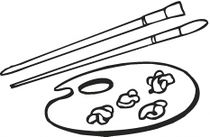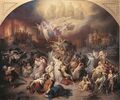Difference between revisions of "Category:Jewish War (subject)"
| (53 intermediate revisions by the same user not shown) | |||
| Line 1: | Line 1: | ||
{| style="margin-top:10px; background:none;" | |||
| style="background:white; width:65%; border:1px solid #a7d7f9; vertical-align:top; color:#000; padding: 5px 10px 10px 8px; -moz-border-radius: 10px; -webkit-border-radius: 10px; border-radius:10px;" | | |||
<!-- ===================== COLONNA DI SINISTRA ==================== --> | |||
{| cellpadding="2" cellspacing="5" style="width:100%; vertical-align:top; background:transparent;" | |||
{{WindowMain | |||
|title= [[Second Temple Studies]] -> (7) Jewish War | |||
|backgroundLogo= Bluebg_rounded_croped.png | |||
|logo= Logo.png | |||
|px= 38 | |||
|content= [[File:Jerusalem Hayez.jpg|600px]] | |||
The '''Jewish War''' (66–73 CE), sometimes called The [[Great Revolt]], or the [[First Jewish-Roman War]] was the first of three major rebellions by the Jews of living in Judaea, against Rome. | |||
< ''[[Second Temple Studies]]'' : (1) [[Babylonian Exile]] -- (2) [[Persian Period]] -- (3) [[Greek Period]] -- (4) [[Maccabees]] -- (5) [[Herods]] -- (6) [[Christian Origins]] -- (7) [[Jewish War]] -- (8) [[Bar Kokhba]] > | |||
< ''[[People]]'' : [[Josephus]] -- [[John of Giscala]] -- [[Eleazar ben Simon]] -- [[Simon bar Giora]] -- [[Eleazar ben Yair]] -- [[Ananus ben Ananus]] -- [[Joshua ben Gamaliel]] -- [[Matthias ben Theophilus]] -- [[Phannias ben Samuel]] -- [[Agrippa II]] -- [[Berenice]] -- [[Tiberius Alexander]] -- [[Nero]] -- [[Gessius Florus]] -- [[Cestius Gallus]] -- [[Vespasian]] -- [[Titus]] -- [[Cerialis]] -- [[Lucilius Bassus]] -- [[Lucius Flavius Silva]] > | |||
< ''[[Events]]'' : [[Battle of Beth Horon]] -- [[Destruction of the Second Temple]] -- [[Fall of Masada]] > | |||
==== The | *This page is edited by [[Samuele Rocca]], Israel | ||
}} | |||
{{WindowMain | |||
|title= Jewish War -- Overview | |||
|backgroundLogo= Bluebg_rounded_croped.png | |||
|logo = logo.png | |||
|px= 38 | |||
|content= | |||
[[File:Titus Romano.jpg|thumb|250px|[[The Triumph of Titus and Vespasian (1540 Romano), art]]]] | |||
[[File:Jerusalem2 Poussin.jpg|thumb|250px|[[Destruction of Jerusalem by Titus (1626 Poussin), art]]]] | |||
[[File:Jerusalem Poussin.jpg|thumb|250px|[[Destruction of Jerusalem by Titus (1637 Poussin), art]]]] | |||
[[File:Arch Titus Bellotto.jpg|thumb|200px|[[Arch of Titus (1744 Bellotto), art]]]] | |||
[[File:Jerusalem Kaulbach.jpg|thumb|250px|[[Destruction of Jerusalem by Titus (1846 Kaulbach), art]]]] | |||
[[File:Jewish War Roberts.jpg|thumb|250px|[[Siege and Destruction of Jerusalem by Titus (1850 Roberts), art]]]] | |||
[[File:Destruction Jerusalem Ge.jpg|thumb|250px|[[The Destruction of Jerusalem (1859 Ge), art]]]] | |||
[[File:Titus Arch Lenbach.jpg|thumb|200px|[[Titus Arch (1860 Lenbach), art]]]] | |||
[[File:Vespasian Alma-Tadema.jpg|thumb|200px|[[Vespasian Hearing from One of His Generals of the Taking of Jerusalem by Titus (1866 Alma-Tadema), art]]]] | |||
[[File:Jerusalem Hayez.jpg|thumb|250px|[[Destruction of the Jerusalem Temple (1867 Hayez), art]]]] | |||
[[File:Titus AlmaTedema.jpg|thumb|200px|[[The Triumph of Titus (1885 Alma-Tadema), art]]]] | |||
The ''Jewish War'' began in the year 66 CE, initially due to Greek and Jewish religious tensions. The Roman military garrison of [[Jerusalem]] was overrun by rebels, who later defeated the Roman army, under the leadership of [[Cestius Gallus]] the Roman governor of [[Syria]], at the [[Battle of Beth Horon]]. While the moderate leaders of the rebellion organized a government in [[Jerusalem]], the rebellion spread to the whole of [[Judaea]]. The emperor [[Nero]] handled the command of the Roman army to [[Vespasian]], who was assisted by various clients–kings, including the Jewish King [[Herod Agrippa II]]. In 67 CE, [[Vespasian]] moved against the Jewish stronghold in [[Galilee]], under the overall command of [[Josephus]] (Joseph ben Mattatihu). The Roman army overwhelmed the Jewish forces in various sieges, as at [[Jotapata]] and [[Gamla]]. [[Josephus]] surrounded and later in the war would side with the Romans. By the end of the year [[Galilee]] was restored to [[Agrippa II]]. The next year, in 68 CE, [[Vespasian]] moved against [[Judaea]], and the neighboring regions. However the fall of [[Nero]] and the Year of the Four Emperors brought a stalemate in the war. Meanwhile in [[Jerusalem]], the moderate Jewish leadership was defeated and killed by the extremist [[Zealots]], under the leadership of [[John of Giscala]], [[Simon bar Giora]] and [[Eleazar ben Simon]]. In 70 CE, Titus, the son of [[Vespasian]] who was left behind by his father, now emperor, to continue the [[Jewish War]], besieged and conquered [[Jerusalem]]. The vast majority of the population was killed or enslaved, the city was burned, and the [[Temple]] razed down. The [[Jewish War]] ended only in 73 CE, with the conquest of the fortress of [[Masada]]. There a group of [[Sicarii]] hold on under the leadership of [[Eleazar ben Yair]]. The Roman commander, [[Flavius Silva]] succeeded in conquering the fortress. According to [[Josephus]] the [[Sicarii]] preferred to commit suicide together with their families, rather than be enslaved by the Romans. | |||
'''The Origins of the War''' | |||
When in 4 BCE [[Herod the Great]] died, the kingdom was divided between his three sons [[Herod Archelaus]], [[Herod Antipas]] and [[Herod Philip]]. [[Herod Archelaus]], appointed by the Roman Emperor [[Augustus]] as ethnarch, received [[Judaea]], [[Samaria]] and [[Idumaea]]. [[Herod Archelaus]]' brothers were appointed to the lesser title of tetrarch. [[Herod Antipas]] received [[Galilee]] and [[Peraea]], while [[Herod Philip]] received the northern territories around the [[Golan]] region. [[Herod Archelaus]] was an ineffective ruler. Already in 4 BCE, the population of [[Judaea]] rebelled against his rule. [[Herod Archelaus]]' brothers fared much better. [[Herod Philip]] ruled his territories till 33 CE. [[Herod Antipas]], who ruled till 39 CE, and, as his father, he urbanized his kingdom. [[Herod Antipas]] founded the city of [[Tiberias]], named in honor of [[Tiberius]]. In 6 CE, after ten year of unhappy rule, [[Herod Archelaus]] was dismissed by [[Augustus]] and sent in exile to [[Gaul]]. His territories were administered by a Roman governor, a [[praefectus]] of equestrian rank, who was responsible to the Roman governor of [[Syria]] of superior senatorial rank. Most of these early governors were quite successful in their task. The only exception was the cruel and corrupt [[Pontius Pilate]], who ruled [[Judaea]] between 26 to 36 CE. In 41 CE [[Judaea]] reverted to an independent status under the rule of [[Herod Agrippa I]], grandson of [[Herod the Great]] and the Hasmonean [[Mariamne]]. The young prince was educated at the Imperial court in Rome. There he became friend with the future emperors [[Caligula]], and [[Claudius]]. [[Agrippa I]] was well rewarded by his imperial friends. In 33 CE he was given by [[Caligula]] the territories of [[Herod Philip]], at the latter's death, and in 39 CE he received the territories of [[Herod Antipas]], after the latter was exiled to southern [[Gaul]]. Finally [[Claudius]] gave to [[Agrippa]] [[Judaea]] itself, the core of the kingdom. [[Agrippa I]] ruled for three peaceful years from 41 to 44 CE. At [[Agrippa I]]'s death, the emperor [[Claudius]] annexed the whole kingdom, and appointed an equestrian governor, with the rank of [[procurator]]. Most of these [[Roman Governors of Judea]] were quite a sad lot, sometime cruel and often corrupted, most of the times unaware of the complexity of Jewish culture and religion, with the conspicuous exceptions of [[Tiberius Alexander]] (the nephew of [[Philo of Alexandria]]) and [[Felix|Marcus Antonius Felix]] (the husband of the Hasmonean [[Drusilla]]). In these years the tension between the Jews and the Romans rose high. On one side the priestly aristocracy, who sided with the Romans, although tried genuinely to protect the subjects from Roman oppression, was seen as collaborators by most of the Jews. The fact that the Roman governor dismissed at his whim the [[High Priest]], the supreme authority of the Jews, lowered his moral authority in the eyes of most of them. On the other side the extremist movements of the [[Zealots]] and of the [[Sicarii]] took foot between the population. According to [[Josephus]], the revolt, which began at [[Caesarea Maritima]] in 66 CE, was provoked by Greeks sacrificing birds in front of a local synagogue. The Roman garrison did not intervene and the long-standing Greek and Jewish religious tensions took a downward spiral. The situation was exacerbated when [[Gessius Florus]], the governor of [[Judaea]] stole money from the coffers of the [[Temple]]. The infuriated population brought [[Gessius Florus]] to flee back to [[Caesarea Maritima]]. It was the beginning of the [[Jewish War]]. | |||
''' The Battle of Beth Horon: The Defeat of Cestius Gallus ''' | |||
The clash between [[Gessius Florus]] and the population of [[Jerusalem]] developed in a full fledged war. [[Gessius Florus]] asked from the citizens of [[Jerusalem]] to welcome two cohorts coming from [[Caesarea Maritima]] to Jerusalem to garrison the city. The former and influential High Priest [[Ananus ben Ananus]] convinced the population to accept. However the auxilia once more misbehaved. This time the population insulted the soldiers, which reacted violently. Immediately the civilians reacted and it begun a strife between the soldiers and the population. [[Gessius Florus]] fled back to [[Caesarea]]. The soldiers remained besieged in the [[Antonia Fortress]]. Then King [[Herod Agrippa II]] came to [[Jerusalem]] to calm the population to quell the rebellion. However, the population received him with insults and accusation of collaboration. Meanwhile the High Priest [[Mattathias ben Theophilus]] ceased the sacrifice to the emperor. This was the real beginning of the insurrection. Although the new government was composed of moderate leaders, as [[Josephus]], who wished peace with Rome, though the fortresses of [[Masada]] and [[Herodium]] were occupied by the extremist [[Sicarii]], which by now, strong of their military successes, could influence the population against their moderate leadership. Meanwhile, in [[Jerusalem]], [[Agrippa II]] still tried to send his own soldiers to make a show of force with the mob. The obvious result was that [[Agrippa II]]'s soldiers were attacked and joined the besieged auxilia in the [[Antonia Fortress]]. | |||
At this point, [[Cestius Gallus]], the Senatorial governor of [[Syria]] organized an expedition against [[Jerusalem]]. He organized the expeditionary corps at [[Ptolemais]] which included a whole legion, the [[XII Fulminata]], and a huge contingent of auxilia. Through [[Caesarea Maritima]], [[Cestius Gallus]], together with his expeditionary army, arrived not far from [[Jerusalem]]. [[Cestius Gallus]]’s army camped on [[Mount Scopus]]. The Roman army then tried to attack [[Jerusalem]], well defended, without success. When [[Cestius Gallus]] army retreated, they were attacked by the rebels. In the [[Battle of Beth Horon]], the Roman army was defeated in an ambuscade, and [[Cestius Gallus]] had to flee to [[Caesarea]]. The Jewish victory of [[Beth Horon]] resulted in a rebellion inside [[Agrippa II]]'s kingdom. Some cities as [[Tiberias]], the capital, took the side of the rebels. Others, as [[Sepphoris]], remained neutral. The rebellion extended from [[Galilee]] to the northern part of [[Agrippa II]] kingdom to the [[Golan]], dominated by the city of [[Gamla]]. One of the effects of the [[Battle of Beth Horon]] was the creation of a well defined Jewish moderate leadership; all major parties were represented in the government. This leadership included [[Sadducees]], or members of the priestly aristocracy, as the former High Priest [[Ananus ben Ananus]], [[Joseph Ben Gurion]], who were given the organization of the defense of Jerusalem; [[Jehoshua Ben Sapphias]] and [[Eleazar ben Anania]], who were given the command of [[Idumaea]], and of course the young [[Josephus]] (Joseph Ben Mattatihu), who was given the command of [[Galilee]]. The moderate leadership also included the Pharisee leader [[Simon ben Gamaliel]] and [[John the Essene]]. On the other side, the Herodian ruler [[Agrippa II]] and his sister [[Berenice]] remained staunch allies of the Romans. | |||
''' The First Campaign in Galilee: Jotapata ''' | |||
By the end of 66 CE, the conflict between the Jews and the Romans was assuming the dimensions not only of a national war between the Jews and the Romans, but also of a civil war, first between Jews and Gentiles, and then between Jews. Thus the conflict soon extended in the mixed cities at the peripheries of Judaea. Thus in the mixed Graeco-Gentile city of [[Caesarea Maritima]], the beginning of the [[Jewish War]] was the excuse for clashes between Jews and Gentiles, and for the latter an excuse to murder the Jewish residents. At [[Skythopolis]], although the local Jewish community did not side with the rebels, the local Jews were however pitilessly murdered. On the other side, in [[Jerusalem]], the [[Sadducee]] moderate leadership was soon contrasted by the [[Zealots]] and [[Sicarii]]. Thus once [[Josephus]] (Joseph ben Mattatihu) assumed the command of the Jewish army in [[Galilee]], he had to face [[John of Giscala]] (Yochanan mi-Gush Halav). The latter together with other leaders, including moderates, were quite successful in undermining [[Josephus]]’s stands in the eyes of the local population. | |||
The [[ | The Roman emperor [[Nero]] was informed of the beginning of the Jewish rebellion during his visit to [[Greece]]. Immediately he called back [[Vespasian]], who had already distinguished himself, during [[Claudius]] conquest of Britannia. By the beginning of 67 CE, [[Vespasian]] was in [[Antiochia]] in [[Syria]]. He therefore began to organize the Roman army to quell the Jewish rebellion. [[Vespasian]]’s army consisted in the [[V Legio Macedonica]], the [[X Legio Fretensis]], in 23 cohortes of auxilia infantry, in six alae of auxilia cavalry, as well as the armies of the king clients [[Herod Agrippa II]], [[Antiochus of Commagene]], [[Soaemus of Emesa]], and [[Malichus II of Nabataea]]. In total [[Vespasian]]’s army included no less than 60.000 soldiers. At [[Ptolemais]] [[Vespasian]] was later joined by his son [[Titus]] coming from [[Alexandria]] with the [[XV Legio Apollinaris]]. [[Vespasian]] first began the conquest of [[Galilee]] and the rest of [[Agrippa]]'s kingdom. At [[Garis]], near [[Sepphoris]] the Jews faced [[Vespasian]]’s army and were defeated in a field battle. [[Josephus]] retired to [[Tiberias]], and then he closes inside [[Jotapata]]. Soon the siege work began; see [[Siege of Jotapata]]. The fortified city was taken and [[Josephus]] captured alive. From then onwards the once commander-in-chief of the insurgents in Galilee collaborated with the Roman army. By the end of the war, he was freed, given Roman citizenship with the name of [[Flavius Josephus]]. | ||
''' The Second Campaign in Galilee: Gamla ''' | |||
Not all the Jewish cities in [[Galilee]] made a last stand as [[Jotapata]]. Thus [[Sepphoris]] from the beginning took the Roman side. [[Tiberias]], the most important city of [[Galilee]], which sided with the rebels after the fall of [[Jotapata]], surrendered to [[Agrippa II]]. The young [[Titus]], second in command to [[Vespasian]], conquered after a short siege the fortress of [[Tarichae]]. Only the settlements of [[Giscala]] (Gush Halav) and [[Har Tavor]] were besieged by the Romans, otherwise all of [[Galilee]] was in their hands. From [[Galilee]], [[Vespasian]] moved to the [[Golan]], and he begun the [[Siege of Gamla]], the last major military operation in the North. | |||
After the conquest and destruction of [[Gamla]], the settlement of [[Giscala]] (Gush Halav) surrendered to [[Titus]] and that of [[Har Tavor]] was conquered. Yet the most important consequences of the [[Jewish War]], were not in [[Galilee]], which by now was buck under the joint control of [[Agrippa II]] and the Romans, but in [[Jerusalem]]. In fact the defeat of [[Gamla]] and the fall of [[Galilee]] was the dead toll for the moderate government in [[Jerusalem]]. Thus the loss of [[Galilee]] brought a civil war between the moderate priestly ruling class, which made off the government, and the [[Zealots]] extremists. The latter seized power, with the help of the [[Idumeans]]. The two former High Priests, [[Ananus ben Ananus]], leader of the [[House of Annas]], and [[Joshua ben Gamaliel]], leader of the [[House of Boethus]], were murdered. In few days the [[Zealots]] overthrow the moderate government and instituted in Jerusalem a reign of terror. The war, however, continued. [[Vespasian]], once secured the kingdom of [[Agrippa II]] moved to [[Perea]] and the [[Decapolis]]. The Gentile cities of [[Gadar]] and [[Gerasa]], in the hands of the Jews, were conquered. [[Vespasian]] then marched on to [[Judaea]]. There the cities of [[Lydda]] and [[Emmaus]] as well as [[Yamnia]], part of the Imperial domain were conquered. By the end of 67 CE, [[Perea]], [[Decapolis]] and [[Judaea]] were in the hands of the Romans. Only [[Jerusalem]] and some fortresses as [[Masada]] and [[Herodium]] as well as [[Idumea]] stood alone in facing the onslaught of the Roman army. | |||
''' The Year of the Four Emperors ''' | |||
The [[Jewish War]] did not end in 68 CE. At the beginning of the year, [[Vespasian]] brought back the army to [[Caesarea Maritima]] to rest in winter camp. But there, he was announced the suicide of the emperor [[Nero]], and the appointment by the army of [[Galba]]. By the beginning of the spring, [[Vespasian]] army completed the conquest of southern [[Judaea]] and of [[Idumaea]]. [[Gophn]] and [[Acrabata]] were conquered as well as the Idumean center of [[Hebron]]. The year 69 CE, the "Year of the Four Emperors" saw a definite stalemate in military operations in Judaea. By the end of 69 CE, [[Vespasian]], a few months before just a military commander, had ascended to the Imperial purple. In Rome, after a few months, [[Galba]] was murdered by the praetorians, who appointed [[Otho]] as the new emperor. However the western legions proclaimed [[Vitellius]] as emperor. Soon [[Vitellius]] army defeated in the first battle of [[Bedriacum]] the rival army of [[Otho]]. The latter did commit suicide in Rome, while [[Vitellius]] entered in the capital. However the civil war was not finished. In the East, the Roman army, strong of its successes in Judaea proclaimed [[Vespasian]] as emperor. [[Herod Agrippa II]] and his sister [[Berenice]] supported the Flavian rise to imperial power (Tacitus, ''Historiae'' II.81). In particular [[Berenice]] was instrumental in securing the support to [[Vespasian]] of her former brother-in-law, the powerful Roman governor of [[Egypt]], the ''Praefectus Egypti'', [[Tiberius Julius Alexander]]. [[Vespasian]] ruler of the East, once in possession of [[Egypt]], could control the food supply to Rome, as its main source was [[Egypt]] itself. [[Vespasian]] was preparing to the conquest of Rome. Thus first [[Vespasian]] left [[Caesarea Maritima]] for [[Alexandria]]. [[Vespasian]] joined forces as well with [[Mucianus]], the governor of Syria, and [[Primus]], a general in [[Pannonia]]. [[Primus]] and [[Mucianus]] led the [[Flavian]] forces against [[Vitellius]], while [[Vespasian]] gained control of [[Egypt]]. [[Vitellius]] was defeated at the second battle of [[Bedriacum]], and [[Vespasian]] was declared emperor by the Roman Senate. Thus [[Vespasian]] left the East for Rome. It is his son [[Titus]], who begun the siege of Jerusalem. | |||
''' The Fall of Jerusalem ''' | |||
The years 68 and 69 CE witnessed a vicious civil war between the various groups of [[Zealots]]. Three main groups confronted each other in [[Jerusalem]]. [[John of Giscala]] (Yohanan mi-Gush Halav), who escaped from [[Galilee]], challenged the leadership of [[Eleazar ben Simon]] in [[Jerusalem]]. Moreover a third new group was organized under the leadership of [[Simon bar Giora]], who arrived at [[Jerusalem]] from [[Masada]]. Each group dominates a different part of the city. Thus [[John of Giscala]] dominated the [[Temple Mount]], [[Simon bar Giora]] dominated the [[Upper City]], and [[Eleazar ben Simon]] dominated the [[Temple]] itself. When a group of pilgrims arrived to the [[Temple]], to celebrate [[Passover]], it was the occasion for [[John of Giscala]] to wipe out the party of [[Eleazar ben Simon]]. By now only the opposing leaders, [[John of Giscala]] and [[Simon bar Giora]], had to join hands and to stand the final clash with the Romans. However during the savage civil war between the different factions all the provisions were burned. There was no more food in [[Jerusalem]], already besieged. The two [[Zealot]] leaders, [[John of Giscala]] and [[Simon bar Giora]] then, although too late, decided to coordinate their efforts in the defense of [[Jerusalem]], as the Roman army approaches. | |||
The [[Siege of Jerusalem]] lasted six months. [[Vespasian]]'s son [[Titus]] led the military operations. King [[Herod Agrippa II]], [[Berenice]], [[Tiberius Alexander]] and the "traitor" [[Josephus]] were among the Jewish leaders who actively supported the Romans. After repeated assaults [[Jesusalem]] fell. The city suffered great destruction. Most of the population was killed or reduced into slavery; the Temple was burnt and left in ruins. Both [[John of Giscala]] and [[Simon bar Giora]] were taken prisoners alive and reserved for [[Titus]]' triumphal procession in Rome. | |||
''' Masada: The Last Stand ''' | |||
With the conquest of [[Jerusalem]], in the summer of 70 CE, the [[Jewish War]] was finished. Still in the outskirts of [[Judaea]] stood Jewish patriots that were not ready to surrender to the Romans, even after the fall of Jerusalem, and the destruction of the [[Temple]]. [[Titus]], however, returned back to Rome to celebrate his triumph. In 72 CE [[Flavius Silva]], of Senatorial rank, the new governor of Judaea, also took the command of the Roman army in Judaea. The main challenge was a group of [[Sicarii]], who dominated in the fortress of [[Masada]], near the [[Dead Sea]]. This group of 960 persons, under the leadership of [[Eleazar ben Yair]], also included women and children, the families of the freedom fighters. Thus [[Silva]] brought there the [[X Legio Fretensis]], as well as six cohorts of auxilia and prepared to besiege the fortress. The siege took place in the winter of 72-73 CE, three years after the destruction of [[Jerusalem]]. The Romans first diverted the aqueducts of the fortress for their own use. Then they erected a circumvallation wall all around [[Masada]]. This wall, built using local stone, was reinforced by towers, erected on the western side and by military camps planned as part of the siege wall. Thus half of the legion, cohorts VI-X, were encamped on the low ground, east of the fortress, and the other half, cohorts I-V, were encamped on the higher ground, to the west. Moreover in this spot, [[Silva]] established his headquarters. The auxiliary cohorts were camped in six other camps. Once [[Masada]] was isolated from the surrounding area, the Romans then build a ramp on the west side of the fortress. This ramp had an incline of 20 degrees, and was built using as frame strata of timbers and covered with earth filling. Jewish prisoners were used to erect the ramp. Roman military engineers were used to fill valleys with their ramps, as during the siege of [[Gergovia]], than in climbing mountains, and a steeply one at that, with the ramp. Once the ramp was ready, the Romans built a siege tower with a battering ram on the front. This siege tower presented special features: as the ramp was quite steeply the siege tower was built following the same inclination. Once the Romans succeeded in bringing the siege tower near the wall of the fortress, the battering ram destroyed the wall of the fortress. However the [[Sicarii]] quickly erected an inner wall of earth and timber, the latter probably taken from the roofs of [[Herod]]'s palaces. More the Romans battered the wall, more the earth, pressed settled in. Thus the Romans had to change their tactics, and they set fire to the inner wall, hoping to burn down the timber frame. However for a while the wind brought back the fire on the siege tower, which begun to burn. Later on, however the wind changed direction and the inner wall erected by the [[Sicarii]] begun to burn down. The Romans were now ready to attack the fortress, but it was not to be. [[Eleazar ben Yair]] called on an assembly of his followers, probably inside a building adjacent the western wall, transformed in a synagogue. There the [[Sicarii]] were persuaded by [[Eleazar ben Yair]] that it was better to commit suicide as free men, than to fall in the hands of the Romans and be enslaved. The [[Sicarii]] committed suicide together with their families. Thus the following morning the Romans found only two old women and two children who survived and told what indeed happened. The [[Jewish War]] was now over. | |||
''' Aftermath ''' | |||
By the end of 73 CE with the exception of most of the Gentile cities as [[Caesarea Maritima]], [[Sebaste]] as well as Greek cities, most notably [[Skythopolis]], Judaea was completely in ruin. The first step taken by the [[Flavians]] was to found colonies in Judaea to control the Jewish subjects. Already [[Nero]] had established the colony of [[Akko-Ptolemais]]. On its coins are depicted the standards of the [[Legion III Gallica]], [[Legion VI Ferrata]], [[Legion X Fretensis]], [[Legion XII Fulminata]]. Thus [[Vespasian]] established a colony at [[Caesarea Maritima]], the [[Colonia Prima Flavia Augusta Caesarea]]. Later on [[Domitian]] established another Roman colony at [[Flavia Neapolis]], modern Schechem. Flavian Judaea was a Senatorial Province, no more equestrian. This would probably stop the abuses that brought the Jews to revolt in 66 CE. Jerusalem was left in ruin, although the [[X Legio Fretensis]] remained there, encamped on the site of Herod's Palace, protected by the three towers of the citadel, which [[Titus]] spared from destruction. Jews, however, continued to live in the area around [[Jerusalem]]. [[Galilee]] was returned to the aging [[Agrippa II]], who died probably in 98 CE. With the death of [[Agrippa II]], the last Herodian ruler, [[Trajan]] annexed [[Galilee]] to the empire. Moreover in 106 CE, [[Trajan]] annexed the neighboring [[Nabatean kingdom]], as the [[Provincia Arabia]]. | |||
''' External links ''' | |||
*[http://en.wikipedia.org/wiki/First Jewish-Roman War Wikipedia] | *[http://en.wikipedia.org/wiki/First Jewish-Roman War Wikipedia] | ||
*[http://www.jewishencyclopedia.com/view.jsp?artid=64&letter=V Jewish Encyclopedia (1906)] | *[http://www.jewishencyclopedia.com/view.jsp?artid=64&letter=V Jewish Encyclopedia (1906)] | ||
}} | |||
{{WindowMain | |||
|title= Jewish War -- Highlights | |||
|backgroundLogo= Bluebg_rounded_croped.png | |||
|logo = contents.png | |||
|px= 38 | |||
|content= | |||
}} | |||
{{WindowMain | |||
|title= [[Jewish War (research)]] | |||
|backgroundLogo= Bluebg_rounded_croped.png | |||
|logo = contents.png | |||
|px= 38 | |||
|content= | |||
}} | |||
|} | |||
|<!-- SPAZI TRA LE COLONNE --> style="border:5px solid transparent;" | | |||
<!-- ===================== COLONNA DI DESTRA ==================== --> | |||
| style="width:35%; border:1px solid #a7d7f9; background:#f5faff; vertical-align:top; padding: 5px 10px 10px 8px; -moz-border-radius: 10px; -webkit-border-radius: 10px; border-radius:10px;"| | |||
{| id="mp-right" cellpadding="2" cellspacing="5" style="width:100%; vertical-align:top; background:#f5faff; background:transparent;" | |||
{{WindowMain | |||
|title= [[Jewish War (literature)|Literature]] | |||
|backgroundLogo= Bluebg_rounded_croped.png | |||
|logo= contents.png | |||
|px= 38 | |||
|content= [[File:Literature.gif|210px]] | |||
}} | |||
{{WindowMain | |||
|title= [[Jewish War (music)|Music]] | |||
|backgroundLogo= Bluebg_rounded_croped.png | |||
|logo= history.png | |||
|px= 38 | |||
|content= [[File:Music.jpg|210px]] | |||
}} | |||
{{WindowMain | |||
|title= [[Jewish War (cinema)|Cinema]] | |||
|backgroundLogo= Bluebg_rounded_croped.png | |||
|logo= history.png | |||
|px= 38 | |||
|content= [[File:Cinema.jpg|210px]] | |||
}} | |||
{{WindowMain | |||
|title= [[Jewish War (art)|Visual Arts]] | |||
|backgroundLogo= Bluebg_rounded_croped.png | |||
|logo= history.png | |||
|px= 38 | |||
|content= [[File:Art2.jpg|210px]] | |||
}} | |||
{{WindowMain | |||
|title= [[Jewish War (fiction)|Fiction]] | |||
|backgroundLogo= Bluebg_rounded_croped.png | |||
|logo= history.png | |||
|px= 38 | |||
|content= | |||
}} | |||
|} | |||
|} | |||
== The Destruction of Jerusalem in Christianity and Rabbinic Judaism == | |||
Different group reacted to the Jewish War in different ways. The War started with a government of national unity that included, Sadducees, Pharisees and Essenes. But the coalition did not last. Since the beginning Hellenistic Jews opposed the war and sided with the Romans. Over time the most radical fringes took power in Jerusalem, and many defected. Some dided with the Romans (including [[Josephus]]) other negotiated with them (the early rabbis), other isolated themselves. | |||
Both the Christians and the rabbis viewed the destruction of Jerusalem as God's punishment. | |||
==== The Flight to Pella and the Vindicta Salvatoris ==== | |||
For the Christians the city was punished for the killing of Jesus. This is openly stated already in Matthew: "Be his blood on us and our children". Christians were also particularly concerned about the messianic implication of the revolt. The official position became that the Christian community left the city before the war and took refuge in Pella, Perea. | |||
: The people of the Church in Jerusalem were commanded by an oracle given by revelation before the war to those in the city who were worthy of it to depart and dwell in one of the cities of Perea which they called Pella. To it those who believed on Christ traveled from Jerusalem, so that when holy men had altogether deserted the royal capital of the Jews and the whole land of Judaea…" — Eusebius, Church History 3, 5, 3. | |||
In the Middle Ages, all Christian narratives on the Jewish War ([[Hegesippus]], [[Vindicta Salvatoris]]) emphasized the idea of the destruction of Jerusalem as divine punishment. | |||
==== The Flight to Yavneh and the Composition of the Mishnah ==== | |||
For the rabbis the city was punished for disobeying the Torah. | |||
According to Rabbinic tradition, Yohanan Ben Zakkai and his disceples left Jerusalem. The story is related in Avoth deRabbi Nathan (version B, chapter 4:5): | |||
:“When Vespasian came to destroy Jerusalem, he said to them: ‘You fools! Why do you seek to burn down the holy house? After all, what am I asking of you? I merely ask that you relinquish unto me each man his bow and arrow, and I will depart from you.’ They answered him in return: ‘Just as we went out against two [Roman armies] that came before you and killed them, so, too, will we go out against you and kill you!’ (i.e. the reference is to the Roman general Cestius who was defeated by the Judeans in 66 CE, marking the beginning of the war with Rome). | |||
:When our Master, Yochanan b. Zakkai, heard these words, he called out to the men of Jerusalem and said to them: ‘My sons, why would you destroy this city, or seek to burn down the holy house!? After all, what is he (i.e. Vespasian) asking of you? Look, he’s not asking from you anything except that you relinquish your bows and arrows, and he’ll depart from you.’ They replied to him: ‘Just as we went out against two [Roman armies] before him and killed them, so, too, we will go out against him and kill him.’ | |||
:Vespasian had armored men positioned along the walls of Jerusalem, and informants within the city. Everything that they’d hear, they’d write it down upon arrows and shoot the arrows outside the wall, one of which said that Rabban Yochanan b. Zakkai was among those that admired the Caesar, and that he’d make mention of this fact to the people of Jerusalem. | |||
When Rabbi Yochanan b. Zakkai’s repeated warnings went unheeded, he sent and called for his disciples, Rabbi Eliezer [b. Hyrcanus] and Rabbi Yehoshua [b. Hananiah]. He said to them: ‘My sons, stand up and take me out of this place! Make me a coffin and I’ll sleep in it.’ Rabbi Eliezer held on to the front end of the coffin, and Rabbi Yehoshua held on to the back end. They carried the coffin as he laid in it until sunset, until they stopped at the gates of Jerusalem’s walls. The porters at the gates enquired who it was that had died. They answered them: ‘It’s a dead man, as if you did not know that we’re not permitted to let a corpse remain within Jerusalem overnight!’ The porters replied: ‘If it’s a dead man, remove him.’ They then removed him, and remained with him until the sun had set, which, by that time, they had reached Vespasian. They opened up the coffin and he stood up before him. He (i.e. Vespasian) enquired of him: ‘Are you Rabban Yochanan b. Zakkai? Ask what I shall give you.’ He said to him: ‘I ask for nothing, except Yavneh (Jamnia). I will go and teach therein my disciples, and I’ll establish therein prayer, and I’ll perform therein all of the duties prescribed in the divine Law.’ He answered him: ‘Go, and do all that you want to do.’ Rabbi Yochanan b. Zakkai then said to him: ‘Would you like me to tell you something?’ Vespasian answered him: ‘Say it.’ He said to him: ‘You are destined to rule over the Roman Empire!’ He asked him: ‘How do you know that?’ He replied: ‘Thus has it been passed down unto us, that the holy house will not be given into the hands of a mere commoner, but rather into the hands of a king, as it says (Isaiah 10:34): He shall cut down the forest thickets with an iron [instrument], and Lebanon shall fall by a mighty one.’ | |||
:They said that no more than two or three days had passed when a certain messenger came from his city, informing him that Caesar had just died, and that they have nominated him to head the Roman Empire. They brought unto him a catapult made of hardened cedar wood, and turned it toward the wall of Jerusalem. They brought unto him planks of cedar wood and put them into the catapult made of hardened cedar wood, and he would hit the wall with them until he made a breach in the wall… | |||
:When Rabban Yochanan b. Zakkai heard that he (i.e Caesar’s son, Titus, who was left to govern the Roman army) destroyed Jerusalem and burnt down the holy house with fire, he rent his clothes, and his disciples rent their clothes, and they were crying and shouting and pounding their chests as mourners, etc.” | |||
The major goal of the Yavnean rabbis seems to have been not the expulsion of those with whom they disagreed but the cessation of sectarianism and the creation of a coalition which tolerated, even encouraged, vigorous debate among members of the fold. The Mishnah is the first work of Jewish antiquity which ascribes conflicting legal opinions to named individuals who, in spite of their disagreements, belong to the same fraternity. This mutual tolerance is the enduring legacy of Yavneh. | |||
Latest revision as of 17:29, 16 November 2020
|
< Second Temple Studies : (1) Babylonian Exile -- (2) Persian Period -- (3) Greek Period -- (4) Maccabees -- (5) Herods -- (6) Christian Origins -- (7) Jewish War -- (8) Bar Kokhba > < People : Josephus -- John of Giscala -- Eleazar ben Simon -- Simon bar Giora -- Eleazar ben Yair -- Ananus ben Ananus -- Joshua ben Gamaliel -- Matthias ben Theophilus -- Phannias ben Samuel -- Agrippa II -- Berenice -- Tiberius Alexander -- Nero -- Gessius Florus -- Cestius Gallus -- Vespasian -- Titus -- Cerialis -- Lucilius Bassus -- Lucius Flavius Silva > < Events : Battle of Beth Horon -- Destruction of the Second Temple -- Fall of Masada >
Jewish War -- Overview The Jewish War began in the year 66 CE, initially due to Greek and Jewish religious tensions. The Roman military garrison of Jerusalem was overrun by rebels, who later defeated the Roman army, under the leadership of Cestius Gallus the Roman governor of Syria, at the Battle of Beth Horon. While the moderate leaders of the rebellion organized a government in Jerusalem, the rebellion spread to the whole of Judaea. The emperor Nero handled the command of the Roman army to Vespasian, who was assisted by various clients–kings, including the Jewish King Herod Agrippa II. In 67 CE, Vespasian moved against the Jewish stronghold in Galilee, under the overall command of Josephus (Joseph ben Mattatihu). The Roman army overwhelmed the Jewish forces in various sieges, as at Jotapata and Gamla. Josephus surrounded and later in the war would side with the Romans. By the end of the year Galilee was restored to Agrippa II. The next year, in 68 CE, Vespasian moved against Judaea, and the neighboring regions. However the fall of Nero and the Year of the Four Emperors brought a stalemate in the war. Meanwhile in Jerusalem, the moderate Jewish leadership was defeated and killed by the extremist Zealots, under the leadership of John of Giscala, Simon bar Giora and Eleazar ben Simon. In 70 CE, Titus, the son of Vespasian who was left behind by his father, now emperor, to continue the Jewish War, besieged and conquered Jerusalem. The vast majority of the population was killed or enslaved, the city was burned, and the Temple razed down. The Jewish War ended only in 73 CE, with the conquest of the fortress of Masada. There a group of Sicarii hold on under the leadership of Eleazar ben Yair. The Roman commander, Flavius Silva succeeded in conquering the fortress. According to Josephus the Sicarii preferred to commit suicide together with their families, rather than be enslaved by the Romans. The Origins of the War When in 4 BCE Herod the Great died, the kingdom was divided between his three sons Herod Archelaus, Herod Antipas and Herod Philip. Herod Archelaus, appointed by the Roman Emperor Augustus as ethnarch, received Judaea, Samaria and Idumaea. Herod Archelaus' brothers were appointed to the lesser title of tetrarch. Herod Antipas received Galilee and Peraea, while Herod Philip received the northern territories around the Golan region. Herod Archelaus was an ineffective ruler. Already in 4 BCE, the population of Judaea rebelled against his rule. Herod Archelaus' brothers fared much better. Herod Philip ruled his territories till 33 CE. Herod Antipas, who ruled till 39 CE, and, as his father, he urbanized his kingdom. Herod Antipas founded the city of Tiberias, named in honor of Tiberius. In 6 CE, after ten year of unhappy rule, Herod Archelaus was dismissed by Augustus and sent in exile to Gaul. His territories were administered by a Roman governor, a praefectus of equestrian rank, who was responsible to the Roman governor of Syria of superior senatorial rank. Most of these early governors were quite successful in their task. The only exception was the cruel and corrupt Pontius Pilate, who ruled Judaea between 26 to 36 CE. In 41 CE Judaea reverted to an independent status under the rule of Herod Agrippa I, grandson of Herod the Great and the Hasmonean Mariamne. The young prince was educated at the Imperial court in Rome. There he became friend with the future emperors Caligula, and Claudius. Agrippa I was well rewarded by his imperial friends. In 33 CE he was given by Caligula the territories of Herod Philip, at the latter's death, and in 39 CE he received the territories of Herod Antipas, after the latter was exiled to southern Gaul. Finally Claudius gave to Agrippa Judaea itself, the core of the kingdom. Agrippa I ruled for three peaceful years from 41 to 44 CE. At Agrippa I's death, the emperor Claudius annexed the whole kingdom, and appointed an equestrian governor, with the rank of procurator. Most of these Roman Governors of Judea were quite a sad lot, sometime cruel and often corrupted, most of the times unaware of the complexity of Jewish culture and religion, with the conspicuous exceptions of Tiberius Alexander (the nephew of Philo of Alexandria) and Marcus Antonius Felix (the husband of the Hasmonean Drusilla). In these years the tension between the Jews and the Romans rose high. On one side the priestly aristocracy, who sided with the Romans, although tried genuinely to protect the subjects from Roman oppression, was seen as collaborators by most of the Jews. The fact that the Roman governor dismissed at his whim the High Priest, the supreme authority of the Jews, lowered his moral authority in the eyes of most of them. On the other side the extremist movements of the Zealots and of the Sicarii took foot between the population. According to Josephus, the revolt, which began at Caesarea Maritima in 66 CE, was provoked by Greeks sacrificing birds in front of a local synagogue. The Roman garrison did not intervene and the long-standing Greek and Jewish religious tensions took a downward spiral. The situation was exacerbated when Gessius Florus, the governor of Judaea stole money from the coffers of the Temple. The infuriated population brought Gessius Florus to flee back to Caesarea Maritima. It was the beginning of the Jewish War. The Battle of Beth Horon: The Defeat of Cestius Gallus The clash between Gessius Florus and the population of Jerusalem developed in a full fledged war. Gessius Florus asked from the citizens of Jerusalem to welcome two cohorts coming from Caesarea Maritima to Jerusalem to garrison the city. The former and influential High Priest Ananus ben Ananus convinced the population to accept. However the auxilia once more misbehaved. This time the population insulted the soldiers, which reacted violently. Immediately the civilians reacted and it begun a strife between the soldiers and the population. Gessius Florus fled back to Caesarea. The soldiers remained besieged in the Antonia Fortress. Then King Herod Agrippa II came to Jerusalem to calm the population to quell the rebellion. However, the population received him with insults and accusation of collaboration. Meanwhile the High Priest Mattathias ben Theophilus ceased the sacrifice to the emperor. This was the real beginning of the insurrection. Although the new government was composed of moderate leaders, as Josephus, who wished peace with Rome, though the fortresses of Masada and Herodium were occupied by the extremist Sicarii, which by now, strong of their military successes, could influence the population against their moderate leadership. Meanwhile, in Jerusalem, Agrippa II still tried to send his own soldiers to make a show of force with the mob. The obvious result was that Agrippa II's soldiers were attacked and joined the besieged auxilia in the Antonia Fortress. At this point, Cestius Gallus, the Senatorial governor of Syria organized an expedition against Jerusalem. He organized the expeditionary corps at Ptolemais which included a whole legion, the XII Fulminata, and a huge contingent of auxilia. Through Caesarea Maritima, Cestius Gallus, together with his expeditionary army, arrived not far from Jerusalem. Cestius Gallus’s army camped on Mount Scopus. The Roman army then tried to attack Jerusalem, well defended, without success. When Cestius Gallus army retreated, they were attacked by the rebels. In the Battle of Beth Horon, the Roman army was defeated in an ambuscade, and Cestius Gallus had to flee to Caesarea. The Jewish victory of Beth Horon resulted in a rebellion inside Agrippa II's kingdom. Some cities as Tiberias, the capital, took the side of the rebels. Others, as Sepphoris, remained neutral. The rebellion extended from Galilee to the northern part of Agrippa II kingdom to the Golan, dominated by the city of Gamla. One of the effects of the Battle of Beth Horon was the creation of a well defined Jewish moderate leadership; all major parties were represented in the government. This leadership included Sadducees, or members of the priestly aristocracy, as the former High Priest Ananus ben Ananus, Joseph Ben Gurion, who were given the organization of the defense of Jerusalem; Jehoshua Ben Sapphias and Eleazar ben Anania, who were given the command of Idumaea, and of course the young Josephus (Joseph Ben Mattatihu), who was given the command of Galilee. The moderate leadership also included the Pharisee leader Simon ben Gamaliel and John the Essene. On the other side, the Herodian ruler Agrippa II and his sister Berenice remained staunch allies of the Romans. The First Campaign in Galilee: Jotapata By the end of 66 CE, the conflict between the Jews and the Romans was assuming the dimensions not only of a national war between the Jews and the Romans, but also of a civil war, first between Jews and Gentiles, and then between Jews. Thus the conflict soon extended in the mixed cities at the peripheries of Judaea. Thus in the mixed Graeco-Gentile city of Caesarea Maritima, the beginning of the Jewish War was the excuse for clashes between Jews and Gentiles, and for the latter an excuse to murder the Jewish residents. At Skythopolis, although the local Jewish community did not side with the rebels, the local Jews were however pitilessly murdered. On the other side, in Jerusalem, the Sadducee moderate leadership was soon contrasted by the Zealots and Sicarii. Thus once Josephus (Joseph ben Mattatihu) assumed the command of the Jewish army in Galilee, he had to face John of Giscala (Yochanan mi-Gush Halav). The latter together with other leaders, including moderates, were quite successful in undermining Josephus’s stands in the eyes of the local population. The Roman emperor Nero was informed of the beginning of the Jewish rebellion during his visit to Greece. Immediately he called back Vespasian, who had already distinguished himself, during Claudius conquest of Britannia. By the beginning of 67 CE, Vespasian was in Antiochia in Syria. He therefore began to organize the Roman army to quell the Jewish rebellion. Vespasian’s army consisted in the V Legio Macedonica, the X Legio Fretensis, in 23 cohortes of auxilia infantry, in six alae of auxilia cavalry, as well as the armies of the king clients Herod Agrippa II, Antiochus of Commagene, Soaemus of Emesa, and Malichus II of Nabataea. In total Vespasian’s army included no less than 60.000 soldiers. At Ptolemais Vespasian was later joined by his son Titus coming from Alexandria with the XV Legio Apollinaris. Vespasian first began the conquest of Galilee and the rest of Agrippa's kingdom. At Garis, near Sepphoris the Jews faced Vespasian’s army and were defeated in a field battle. Josephus retired to Tiberias, and then he closes inside Jotapata. Soon the siege work began; see Siege of Jotapata. The fortified city was taken and Josephus captured alive. From then onwards the once commander-in-chief of the insurgents in Galilee collaborated with the Roman army. By the end of the war, he was freed, given Roman citizenship with the name of Flavius Josephus. The Second Campaign in Galilee: Gamla Not all the Jewish cities in Galilee made a last stand as Jotapata. Thus Sepphoris from the beginning took the Roman side. Tiberias, the most important city of Galilee, which sided with the rebels after the fall of Jotapata, surrendered to Agrippa II. The young Titus, second in command to Vespasian, conquered after a short siege the fortress of Tarichae. Only the settlements of Giscala (Gush Halav) and Har Tavor were besieged by the Romans, otherwise all of Galilee was in their hands. From Galilee, Vespasian moved to the Golan, and he begun the Siege of Gamla, the last major military operation in the North. After the conquest and destruction of Gamla, the settlement of Giscala (Gush Halav) surrendered to Titus and that of Har Tavor was conquered. Yet the most important consequences of the Jewish War, were not in Galilee, which by now was buck under the joint control of Agrippa II and the Romans, but in Jerusalem. In fact the defeat of Gamla and the fall of Galilee was the dead toll for the moderate government in Jerusalem. Thus the loss of Galilee brought a civil war between the moderate priestly ruling class, which made off the government, and the Zealots extremists. The latter seized power, with the help of the Idumeans. The two former High Priests, Ananus ben Ananus, leader of the House of Annas, and Joshua ben Gamaliel, leader of the House of Boethus, were murdered. In few days the Zealots overthrow the moderate government and instituted in Jerusalem a reign of terror. The war, however, continued. Vespasian, once secured the kingdom of Agrippa II moved to Perea and the Decapolis. The Gentile cities of Gadar and Gerasa, in the hands of the Jews, were conquered. Vespasian then marched on to Judaea. There the cities of Lydda and Emmaus as well as Yamnia, part of the Imperial domain were conquered. By the end of 67 CE, Perea, Decapolis and Judaea were in the hands of the Romans. Only Jerusalem and some fortresses as Masada and Herodium as well as Idumea stood alone in facing the onslaught of the Roman army. The Year of the Four Emperors The Jewish War did not end in 68 CE. At the beginning of the year, Vespasian brought back the army to Caesarea Maritima to rest in winter camp. But there, he was announced the suicide of the emperor Nero, and the appointment by the army of Galba. By the beginning of the spring, Vespasian army completed the conquest of southern Judaea and of Idumaea. Gophn and Acrabata were conquered as well as the Idumean center of Hebron. The year 69 CE, the "Year of the Four Emperors" saw a definite stalemate in military operations in Judaea. By the end of 69 CE, Vespasian, a few months before just a military commander, had ascended to the Imperial purple. In Rome, after a few months, Galba was murdered by the praetorians, who appointed Otho as the new emperor. However the western legions proclaimed Vitellius as emperor. Soon Vitellius army defeated in the first battle of Bedriacum the rival army of Otho. The latter did commit suicide in Rome, while Vitellius entered in the capital. However the civil war was not finished. In the East, the Roman army, strong of its successes in Judaea proclaimed Vespasian as emperor. Herod Agrippa II and his sister Berenice supported the Flavian rise to imperial power (Tacitus, Historiae II.81). In particular Berenice was instrumental in securing the support to Vespasian of her former brother-in-law, the powerful Roman governor of Egypt, the Praefectus Egypti, Tiberius Julius Alexander. Vespasian ruler of the East, once in possession of Egypt, could control the food supply to Rome, as its main source was Egypt itself. Vespasian was preparing to the conquest of Rome. Thus first Vespasian left Caesarea Maritima for Alexandria. Vespasian joined forces as well with Mucianus, the governor of Syria, and Primus, a general in Pannonia. Primus and Mucianus led the Flavian forces against Vitellius, while Vespasian gained control of Egypt. Vitellius was defeated at the second battle of Bedriacum, and Vespasian was declared emperor by the Roman Senate. Thus Vespasian left the East for Rome. It is his son Titus, who begun the siege of Jerusalem. The Fall of Jerusalem The years 68 and 69 CE witnessed a vicious civil war between the various groups of Zealots. Three main groups confronted each other in Jerusalem. John of Giscala (Yohanan mi-Gush Halav), who escaped from Galilee, challenged the leadership of Eleazar ben Simon in Jerusalem. Moreover a third new group was organized under the leadership of Simon bar Giora, who arrived at Jerusalem from Masada. Each group dominates a different part of the city. Thus John of Giscala dominated the Temple Mount, Simon bar Giora dominated the Upper City, and Eleazar ben Simon dominated the Temple itself. When a group of pilgrims arrived to the Temple, to celebrate Passover, it was the occasion for John of Giscala to wipe out the party of Eleazar ben Simon. By now only the opposing leaders, John of Giscala and Simon bar Giora, had to join hands and to stand the final clash with the Romans. However during the savage civil war between the different factions all the provisions were burned. There was no more food in Jerusalem, already besieged. The two Zealot leaders, John of Giscala and Simon bar Giora then, although too late, decided to coordinate their efforts in the defense of Jerusalem, as the Roman army approaches. The Siege of Jerusalem lasted six months. Vespasian's son Titus led the military operations. King Herod Agrippa II, Berenice, Tiberius Alexander and the "traitor" Josephus were among the Jewish leaders who actively supported the Romans. After repeated assaults Jesusalem fell. The city suffered great destruction. Most of the population was killed or reduced into slavery; the Temple was burnt and left in ruins. Both John of Giscala and Simon bar Giora were taken prisoners alive and reserved for Titus' triumphal procession in Rome. Masada: The Last Stand With the conquest of Jerusalem, in the summer of 70 CE, the Jewish War was finished. Still in the outskirts of Judaea stood Jewish patriots that were not ready to surrender to the Romans, even after the fall of Jerusalem, and the destruction of the Temple. Titus, however, returned back to Rome to celebrate his triumph. In 72 CE Flavius Silva, of Senatorial rank, the new governor of Judaea, also took the command of the Roman army in Judaea. The main challenge was a group of Sicarii, who dominated in the fortress of Masada, near the Dead Sea. This group of 960 persons, under the leadership of Eleazar ben Yair, also included women and children, the families of the freedom fighters. Thus Silva brought there the X Legio Fretensis, as well as six cohorts of auxilia and prepared to besiege the fortress. The siege took place in the winter of 72-73 CE, three years after the destruction of Jerusalem. The Romans first diverted the aqueducts of the fortress for their own use. Then they erected a circumvallation wall all around Masada. This wall, built using local stone, was reinforced by towers, erected on the western side and by military camps planned as part of the siege wall. Thus half of the legion, cohorts VI-X, were encamped on the low ground, east of the fortress, and the other half, cohorts I-V, were encamped on the higher ground, to the west. Moreover in this spot, Silva established his headquarters. The auxiliary cohorts were camped in six other camps. Once Masada was isolated from the surrounding area, the Romans then build a ramp on the west side of the fortress. This ramp had an incline of 20 degrees, and was built using as frame strata of timbers and covered with earth filling. Jewish prisoners were used to erect the ramp. Roman military engineers were used to fill valleys with their ramps, as during the siege of Gergovia, than in climbing mountains, and a steeply one at that, with the ramp. Once the ramp was ready, the Romans built a siege tower with a battering ram on the front. This siege tower presented special features: as the ramp was quite steeply the siege tower was built following the same inclination. Once the Romans succeeded in bringing the siege tower near the wall of the fortress, the battering ram destroyed the wall of the fortress. However the Sicarii quickly erected an inner wall of earth and timber, the latter probably taken from the roofs of Herod's palaces. More the Romans battered the wall, more the earth, pressed settled in. Thus the Romans had to change their tactics, and they set fire to the inner wall, hoping to burn down the timber frame. However for a while the wind brought back the fire on the siege tower, which begun to burn. Later on, however the wind changed direction and the inner wall erected by the Sicarii begun to burn down. The Romans were now ready to attack the fortress, but it was not to be. Eleazar ben Yair called on an assembly of his followers, probably inside a building adjacent the western wall, transformed in a synagogue. There the Sicarii were persuaded by Eleazar ben Yair that it was better to commit suicide as free men, than to fall in the hands of the Romans and be enslaved. The Sicarii committed suicide together with their families. Thus the following morning the Romans found only two old women and two children who survived and told what indeed happened. The Jewish War was now over. Aftermath By the end of 73 CE with the exception of most of the Gentile cities as Caesarea Maritima, Sebaste as well as Greek cities, most notably Skythopolis, Judaea was completely in ruin. The first step taken by the Flavians was to found colonies in Judaea to control the Jewish subjects. Already Nero had established the colony of Akko-Ptolemais. On its coins are depicted the standards of the Legion III Gallica, Legion VI Ferrata, Legion X Fretensis, Legion XII Fulminata. Thus Vespasian established a colony at Caesarea Maritima, the Colonia Prima Flavia Augusta Caesarea. Later on Domitian established another Roman colony at Flavia Neapolis, modern Schechem. Flavian Judaea was a Senatorial Province, no more equestrian. This would probably stop the abuses that brought the Jews to revolt in 66 CE. Jerusalem was left in ruin, although the X Legio Fretensis remained there, encamped on the site of Herod's Palace, protected by the three towers of the citadel, which Titus spared from destruction. Jews, however, continued to live in the area around Jerusalem. Galilee was returned to the aging Agrippa II, who died probably in 98 CE. With the death of Agrippa II, the last Herodian ruler, Trajan annexed Galilee to the empire. Moreover in 106 CE, Trajan annexed the neighboring Nabatean kingdom, as the Provincia Arabia. External links
Jewish War -- Highlights
|
|
The Destruction of Jerusalem in Christianity and Rabbinic Judaism
Different group reacted to the Jewish War in different ways. The War started with a government of national unity that included, Sadducees, Pharisees and Essenes. But the coalition did not last. Since the beginning Hellenistic Jews opposed the war and sided with the Romans. Over time the most radical fringes took power in Jerusalem, and many defected. Some dided with the Romans (including Josephus) other negotiated with them (the early rabbis), other isolated themselves.
Both the Christians and the rabbis viewed the destruction of Jerusalem as God's punishment.
The Flight to Pella and the Vindicta Salvatoris
For the Christians the city was punished for the killing of Jesus. This is openly stated already in Matthew: "Be his blood on us and our children". Christians were also particularly concerned about the messianic implication of the revolt. The official position became that the Christian community left the city before the war and took refuge in Pella, Perea.
- The people of the Church in Jerusalem were commanded by an oracle given by revelation before the war to those in the city who were worthy of it to depart and dwell in one of the cities of Perea which they called Pella. To it those who believed on Christ traveled from Jerusalem, so that when holy men had altogether deserted the royal capital of the Jews and the whole land of Judaea…" — Eusebius, Church History 3, 5, 3.
In the Middle Ages, all Christian narratives on the Jewish War (Hegesippus, Vindicta Salvatoris) emphasized the idea of the destruction of Jerusalem as divine punishment.
The Flight to Yavneh and the Composition of the Mishnah
For the rabbis the city was punished for disobeying the Torah.
According to Rabbinic tradition, Yohanan Ben Zakkai and his disceples left Jerusalem. The story is related in Avoth deRabbi Nathan (version B, chapter 4:5):
- “When Vespasian came to destroy Jerusalem, he said to them: ‘You fools! Why do you seek to burn down the holy house? After all, what am I asking of you? I merely ask that you relinquish unto me each man his bow and arrow, and I will depart from you.’ They answered him in return: ‘Just as we went out against two [Roman armies] that came before you and killed them, so, too, will we go out against you and kill you!’ (i.e. the reference is to the Roman general Cestius who was defeated by the Judeans in 66 CE, marking the beginning of the war with Rome).
- When our Master, Yochanan b. Zakkai, heard these words, he called out to the men of Jerusalem and said to them: ‘My sons, why would you destroy this city, or seek to burn down the holy house!? After all, what is he (i.e. Vespasian) asking of you? Look, he’s not asking from you anything except that you relinquish your bows and arrows, and he’ll depart from you.’ They replied to him: ‘Just as we went out against two [Roman armies] before him and killed them, so, too, we will go out against him and kill him.’
- Vespasian had armored men positioned along the walls of Jerusalem, and informants within the city. Everything that they’d hear, they’d write it down upon arrows and shoot the arrows outside the wall, one of which said that Rabban Yochanan b. Zakkai was among those that admired the Caesar, and that he’d make mention of this fact to the people of Jerusalem.
When Rabbi Yochanan b. Zakkai’s repeated warnings went unheeded, he sent and called for his disciples, Rabbi Eliezer [b. Hyrcanus] and Rabbi Yehoshua [b. Hananiah]. He said to them: ‘My sons, stand up and take me out of this place! Make me a coffin and I’ll sleep in it.’ Rabbi Eliezer held on to the front end of the coffin, and Rabbi Yehoshua held on to the back end. They carried the coffin as he laid in it until sunset, until they stopped at the gates of Jerusalem’s walls. The porters at the gates enquired who it was that had died. They answered them: ‘It’s a dead man, as if you did not know that we’re not permitted to let a corpse remain within Jerusalem overnight!’ The porters replied: ‘If it’s a dead man, remove him.’ They then removed him, and remained with him until the sun had set, which, by that time, they had reached Vespasian. They opened up the coffin and he stood up before him. He (i.e. Vespasian) enquired of him: ‘Are you Rabban Yochanan b. Zakkai? Ask what I shall give you.’ He said to him: ‘I ask for nothing, except Yavneh (Jamnia). I will go and teach therein my disciples, and I’ll establish therein prayer, and I’ll perform therein all of the duties prescribed in the divine Law.’ He answered him: ‘Go, and do all that you want to do.’ Rabbi Yochanan b. Zakkai then said to him: ‘Would you like me to tell you something?’ Vespasian answered him: ‘Say it.’ He said to him: ‘You are destined to rule over the Roman Empire!’ He asked him: ‘How do you know that?’ He replied: ‘Thus has it been passed down unto us, that the holy house will not be given into the hands of a mere commoner, but rather into the hands of a king, as it says (Isaiah 10:34): He shall cut down the forest thickets with an iron [instrument], and Lebanon shall fall by a mighty one.’
- They said that no more than two or three days had passed when a certain messenger came from his city, informing him that Caesar had just died, and that they have nominated him to head the Roman Empire. They brought unto him a catapult made of hardened cedar wood, and turned it toward the wall of Jerusalem. They brought unto him planks of cedar wood and put them into the catapult made of hardened cedar wood, and he would hit the wall with them until he made a breach in the wall…
- When Rabban Yochanan b. Zakkai heard that he (i.e Caesar’s son, Titus, who was left to govern the Roman army) destroyed Jerusalem and burnt down the holy house with fire, he rent his clothes, and his disciples rent their clothes, and they were crying and shouting and pounding their chests as mourners, etc.”
The major goal of the Yavnean rabbis seems to have been not the expulsion of those with whom they disagreed but the cessation of sectarianism and the creation of a coalition which tolerated, even encouraged, vigorous debate among members of the fold. The Mishnah is the first work of Jewish antiquity which ascribes conflicting legal opinions to named individuals who, in spite of their disagreements, belong to the same fraternity. This mutual tolerance is the enduring legacy of Yavneh.
Pages in category "Jewish War (subject)"
The following 129 pages are in this category, out of 129 total.
1
- == == 1450s == == ==
- Josephus de la Bataille Judaique (Josephus's Jewish War / 1492), book
- De bello judaico (Jewish War / 1492 Palencia), book
- Guerra dei Giudei (1493), book
- == == 1500s == == ==
- The Triumph of Titus and Vespasian (1540 Romano), art
- The Destruction of Jerusalem (1577 Legge), play
- The Destruction of Jerusalem (1584 Smythe), play
- La gitana melancólica (1608 Aguilar), play
- Hierusalem Verwoest (Jerusalem Laid Desolate / 1620 Vondel), play (Dutch)
- The Jewes Tragedy (1626 Heminges), play
- Destruction of Jerusalem by Titus (1626 Poussin), art
- La Giudea distrutta da Vespasiano e Tito (1627 Finella), play
- L’ebrea famelica (The Famishing Jewess / 1640 Caputi / Vittori), oratorio (music & libretto)
- Los desagravios de Christo (1640 Cubillo de Aragón), play
- The Destruction of Jerusalem by Titus Vespasian (1677 Crowne), play
- Gerusalemme destrutta da Tito (1691 Cattani / Fineschi), oratorio
- Die Zerstörung Jerusalems (The Destruction of Jerusalem / 1692 Conradi / Postel), opera (music & libretto), Hamburg premiere
- La Gerusalemme convertita (1733 Caldara / Zeno), oratorio
- La Gerusalemme convertita (1733 Zeno), libretto
- La Gerusalemme convertita (1751 Galuppi / Zeno), oratorio
- Giovanni di Giscala (John of Giscala / 1754 Varano), play
- La Gerusalemme convertita (1755 Jommelli / Zeno), oratorio
- The Siege of Jerusalem by Titus Vespasian (1763 Latter), play
- The Siege of Jerusalem (1769 Bowes Strathmore), play
- Historia verdadera de la lamentable destrucción de Jerusalén, y triste desolación del pueblo Judaico (1777 Martín), book
- Gerusalemme distrutta (1812 Dusik), oratorio
- La distruzione di Gerusalemme (The Destruction of Jerusalem / 1812 Zingarelli / Sografi), opera (music & libretto), Milan premiere (cast)
- Jeruzsálem pusztulása (The Destruction of Jerusalem / 1814 Katona), play
- Solyme conquise; ou, La dispersion des juifs (1819 Desquiron), poetry
- The Wandering Jew (1820 Galt), novel
- The Fall of Jerusalem (1820 Milman), play
- The Wars of the Jews (1823 Johnstone / Brooke), juvenile novel & art
- Salathiel (1827 Croly), novel
- Geschichte der Römerherrschaft in Judäa und der Zerstörung Jerusalems (1847 @1847 Salvador / Eichler), book (German ed.)
- Histoire de la domination romaine en Judée et de la ruine de Jérusalem (1847 Salvador), book
- Siege and Destruction of Jerusalem by Titus (1850 Roberts), art
- Titus; oder, Die Zerstörung Jerusalems (1855 Kossarski), play
- Giovanni Giscala (John of Giscala / 1855 Rossi / Cavagnari), opera (music & libretto), Parma premiere
- L'ultimo giorno di Gerusalemme (1858 Lucchesi), opera
- La distruzione di Gerusalemme (The Destruction of Jerusalem / 1858 Pacini / Fioretti), oratorio (music & libretto), Florence premiere (cast)
- The Destruction of Jerusalem (1859 Ge), art
- The False Christ (1860 Charles), novel
- The Gladiators (1863 Whyte-Melville), novel
- Vespasian Hearing from One of His Generals of the Taking of Jerusalem by Titus (1866 Alma-Tadema), art
- Siége de Jotapata (1866 Parent), book
- Les derniers jours de Jérusalem (1866 Saulcy), book
- Salome (1867 Heywood), play
- Der Messias (1869 Gensichen), play
- The Triumph of Titus (1885 Alma-Tadema), art
- The Destruction of Jerusalem (1885 Landau), play
- Сказание о Флоре, Агриппе и Менахеме, сыне Иегуды (1886 Korolenko), novel
- For the Temple (1888 Henty), novel
- The Cross Triumphant (1895 Kingsley), novel
- Lucius Flavus (1898 Spillmann), novel (German)
- Josephus Flavius: Charakterystyka cztowieka i historyka na tle wspotczesnych wypadkow (1904 Balaban), book (Polish)
- Ahasver (1905 Diener/Hesslein), play
- Lucius Flavus (1906 Spillmann), novel (Italian ed.)
- The Forgotten Door (1907 Cowper), novel
- The City of Delight (1908 Miller), novel
- The Doomed City (1910 Carling), novel
- Metzadah (1927 Lamdan), poetry
- Be-lel zeh (1935 Bistritzky), play
- Yerushalayim ve-Romi: Yosifus Flavyus (1939 Bistritzky), play
- Bi-nefol Metsadah (1940 Braslavski), children's novel
- The Fall of Jerusalem and the Christian Church (1951 Brandon), book
- If I Forget Thee (1956 De Ropp), novel
- Aharit Metsadah (1959 Braslavski/Weil), children's novel
- Metsadah (1966 Yadin), book
- The Rider and His Horse (1968 Haugaard/Dillon), children's novel
- The Last Days (1968 Rayner), novel
- The Children of the Cave (1969 Livneh), children's novel
- The End of Days (1970 Gavron), novel
- Masada (1970 Greenberg), oratorio
- The Besieged (1972 Gant), novel
- Masada (1973 Berman), novel
- Masada Will Not Fall Again (1973 Greenspan), novel
- The Voices of Masada (1973 Kossoff), novel
- Metsadah 967 (Masada 967 / 1973 Tal / Eliraz), opera (music & libretto)
- A Time to Die (1974 Golden), novel
- Rzym i Jerozolima (1974 Krawczuk), book
- The Gladiator: Hill of the Dead (1975 Bulmer), novel
- Israel in Revolution, 6-74 CE (1976 Rhoads), book
- The Wolf of Masada (1978 Fredman), novel
- Last Night on Masada (1979 Douglas), novel
- Massada: les guerriers de Dieu (1979 Rachet), novel
- Zwölf Steine für Judäa (1979 Zitelmann), novel
- The Tenth Measure (1980 Segal), novel
- Masada (1980 Tacconi), novel
- Serpent (1981 Mosley), novel
- Ani zokher et Metsadah (1982 Ron-Feder/Harel), children's novel
- Sieg im Tod: Masada (1982 Weiss), novel
- Masada (1983 Brogan), novel
- Masada (1983 @1981 Sagal), TV mini-series (Italian ed.)
- `Ir melukah (1984 Baram), novel
- Lazare; ou, Le grand sommeil (1985 Absire), novel
- The Ruling Class of Judea: The Origins of the Jewish Revolt against Rome (1987 Goodman), book
- Masada (1987 Levy), oratorio
- The Tenth of Av (1988 Roseman), novel
- Le royaume de la Torah (1989 Baram), novel (French ed.)
- The Man of Masada (1990 Brogan), novel
- Flavius Josephus, the Zealots and Yavne (1994 Bohrmann), book (English ed.)
- The Road to Masada (1994 Elwood), novel
- Les voix de l'exil: un siècle à Jérusalem (1994 Lévy), novel
- The Fall of Jerusalem (1994 Wise), novel
- Milim (Metamorphosis of a Melody / 1996 Gitai), feature film
- Turbulent Times?: Josephus and Scholarship on Judaea in the First Century CE (1998 McLaren), book
- Masada: The Last Fortress (1998 Miklowitz), novel
- Le rivolte giudaiche (1999 Firpo), book
- Vespasian (1999 Levick), book
2
- Keeping Faith in the Dust (2000 Maltz), novel
- Return to Masada (2001 Makin), novel
- The First Jewish Revolt (2002 Berlin/Overman), edited volume
- אני, שלום בת שמואל (I, Shalom bat Shmuel / 2003 Ben-Guigui Yeger), novel
- The Fall of Jerusalem (2003 Muldowney / Fenton), oratorio
- The Masada Scroll (2006 Block/Vaughan), novel
- Ancient Rome: Rebellion (2006 Grieve), TV film
- Masada (2007 Siliato), novel
- Jerusalem's Traitor: Josephus, Masada, and the Fall of Judea (2008 Seward), non-fiction
- The Jews against Rome: War in Palestine AD 66-73 (2008 Sorek), book
- Masada: An Epic Story (2009 Eshel), book (English ed.)
- מצדה (Masada / 2009 Eshel), book
- == == 2010s == == ==
- Jewish Reactions to the Destruction of Jerusalem in AD 70 (2011 Jones), book
- The Jewish Revolt against Rome (2011 Popović), edited volume
- The Last Man (2012 Deutermann), novel
- The Last Temple (2012 Hanegraaff, Brouwer), novel
- Le guerre ebraiche dei Romani (The Jewish Wars of the Romans / 2015 Lewin), book
- The Destruction of Jerusalem in Early Modern English Literature (2015 Groves), book
Media in category "Jewish War (subject)"
The following 17 files are in this category, out of 17 total.
- 1637 * Poussin (art).jpg 800 × 593; 110 KB
- 1744 Bellotto (art).jpg 2,536 × 3,406; 740 KB
- 1840 * Peploe (novel).jpg 375 × 499; 25 KB
- 1846 * Kaulbach (art).jpg 723 × 600; 106 KB
- 1860 Lenbach (art).jpg 401 × 599; 78 KB
- 1867 * Hayez (art).jpg 800 × 585; 108 KB
- 1966 * Yadin.jpg 379 × 499; 48 KB
- 1970 * Gann (novel).jpg 300 × 436; 22 KB
- 1981 * Sagal (TV miniseries).jpg 214 × 317; 12 KB
- 1983 Pfanner - Hess - Schwanke.jpg 182 × 249; 3 KB
- 1991 Yarden.jpg 260 × 346; 11 KB
- 1993 * Rivers (novel).jpg 999 × 1,500; 133 KB
- 1995 * Ben-Yehuda.jpg 328 × 499; 26 KB
- 2007 * Goodman.jpg 324 × 499; 34 KB
- 2011 * Hoffman (novel).jpg 333 × 499; 29 KB
- 2020-E Chapot.jpg 400 × 601; 73 KB
- 2021 Giambrone.jpg 334 × 499; 13 KB
